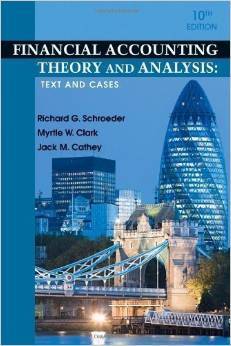Test Bank For Financial Accounting Theory and Analysis: Text and Cases Tenth (10th) By Richard G. Schroeder, Myrtle W. Clark, Jack M. Cathey
$35.00 Original price was: $35.00.$26.50Current price is: $26.50.
Test Bank For Financial Accounting Theory and Analysis: Text and Cases Tenth (10th) By Richard G. Schroeder, Myrtle W. Clark, Jack M. Cathey
Test Bank For Financial Accounting Theory and Analysis: Text and Cases Tenth (10th) By Richard G. Schroeder, Myrtle W. Clark, Jack M. Cathey
Product details:
- ISBN-10 : 0470646284
- ISBN-13 : 978-0470646281
- Author: Richard
Updated and revised, this tenth edition helps accountants build strong critical thinking skills and a sound theoretical background. This enables them to evaluate accounting practice in today’s increasingly global world economy. A unique and timely collection of cases and readings cover all areas of accounting and shows how the latest accounting standards impact decision making. New FASB codification cases provide up-to-date information. Room for Debate cases in each chapter, as well as updated disclosure examples throughout the book, also engage accountants as they learn how the material relates to their profession.
Table of contents:
1 The Development of Accounting Theory 1
The Early History of Accounting 2
Accounting in the United States since 1930 5
The Role of Ethics in Accounting 21
International Accounting Standards 25
Cases 27
FASB ASC Research 29
Room for Debate 30
2 The Pursuit of the Conceptual Framework 31
The Early Theorists 31
Early Authoritative and Semi-Authoritatve Organizational Attempts to Develop the Conceptual Framework of Accounting 34
The FASB’s Conceptual Framework Project 45
Principles-Based versus Rules-Based Accounting Standards 58
International Convergence 63
Cases 73
FASB ASC Research 76
Room for Debate 77
3 International Accounting 78
International Business Accounting Issues 79
The Development of Accounting Systems 79
Preparation of Financial Statements for Foreign Users 81
The International Accounting Standards Committee 82
Revising the IASB’s Constitution 88
The Uses of International Accounting Standards 90
Current Issues 91
The IASB Annual Improvements Project 92
The Use of IASC Standards 93
The IASB-FASB Convergence Project 93
The Impact of International versus U.S. GAAP Accounting Standards 97
Standards Overload 99
Framework for the Preparation and Presentation of Financial Statements 100
Comparison of the IASB’s and FASB’s Conceptual Frameworks 103
IAS No. 1 and IFRS No. 1 107
Cases 109
FASB ASC Research 110
Room for Debate 111
4 Research Methodology and Theories on the Uses of Accounting Information 112
Research Methodology 113
The Outcomes of Providing Accounting Information 115
The Relationship Among Research, Education, and Practice 129
Cases 130
FASB ASC Research 132
Room for Debate 132
5 Income Concepts 134
The Nature of Income 136
Income Recognition 141
Earnings Quality, Earnings Management, and Fraudulent Financial Reporting 154
Cases 159
FASB ASC Research 163
Room for Debate 164
6 Financial Statements I: The Income Statement 166
The Economic Consequences of Financial Reporting 166
Income Statement Elements 167
Statement Format 168
Proposed Format of the Statement of Comprehensive Income 192
The Value of Corporate Earnings 195
International Accounting Standards 199
Cases 203
FASB ASC Research 209
Room for Debate 210
7 Financial Statements II: The Balance Sheet and the Statement of Cash Flows 211
The Balance Sheet 212
Fair Value Measurements Under SFAS No. 157 224
Proposed Format of the Statement of Financial Position 229
Evaluating a Company’s Financial Position 231
The Statement of Cash Flows 235
Financial Analysis of Cash-flow Information 246
International Accounting Standards 247
Cases 249
FASB ASC Research 253
Room for Debate 254
8 Working Capital 255
Development of the Working Capital Concept 255
Current Usage 257
Components of Working Capital 258
Financial Analysis of a Company’s Working Capital Position 270
International Accounting Standards 276
Cases 277
FASB ASC Research 281
Room for Debate 282
9 Long-Term Assets I: Property, Plant, and Equipment 284
Property, Plant, and Equipment 284
Financial Analysis of Property, Plant, and Equipment 289
International Accounting Standards 300
Cases 305
FASB ASC Research 310
Room for Debate 311
10 Long-Term Assets II: Investments and Intangibles 313
Investments in Equity Securities 313
Investments in Debt Securities 322
Impairment of Investments in Unsecuritized Debt 325
Transfers of Financial Assets 326
Intangibles 327
Financial Analysis of Investments and Intangibles 337
International Accounting Standards 337
Cases 343
FASB ASC Research 347
Room for Debate 348
11 Long-Term Liabilities 350
The Definition of Liabilities 351
Recognition and Measurement of Liabilities 352
Debt versus Equity 352
Long-Term Debt Classification 357
Other Liability Measurement Issues 370
Troubled Debt Restructurings 375
Financial Analysis of Long-Term Debt 378
International Accounting Standards 381
Cases 385
FASB ASC Research 390
Room for Debate 392
12 Accounting for Income Taxes 393
Historical Perspective 393
The Income Tax Allocation Issue 395
SFAS No. 109 411
Financial Analysis of Income Taxes 417
International Accounting Standards 420
Cases 423
FASB ASC Research 426
Room for Debate 427
13 Leases 429
Accounting for Leases 430
Financial Analysis of Leases 444
International Accounting Standards 447
Cases 449
FASB ASC Research 453
Room for Debate 454
14 Pensions and Other Postretirement Benefits 456
Historical Perspective 458
Accounting for the Pension Fund 469
The Employee Retirement Income Security Act 470
Other Postretirement Benefits 470
SFAS No. 132 473
SFAS No. 158 473
Financial Analysis of Pension and Other Postretirement Benefits 475
International Accounting Standards 476
Cases 477
FASB ASC Research 479
Room for Debate 481
15 Equity 482
Theories of Equity 483
Definition of Equity 488
Reporting Equity 491
Financial Analysis of Stockholders’ Equity 505
International Accounting Standards 506
Cases 508
FASB ASC Research 513
Room for Debate 514
16 Accounting for Multiple Entities 515
Business Combinations 515
Accounting for Business Combinations 516
Business Combinations II 522
Theories of Consolidation 525
Noncontrolling Interest 526
Drawbacks of Consolidation 529
Special-Purpose Entities 530
Segment Reporting 531
Foreign Currency Translation 536
International Accounting Standards 544
Cases 548
FASB ASC Research 551
Room for Debate 552
17 Financial Reporting Disclosure Requirements and Ethical Responsibilities 554
Recognition and Measurement Criteria 554
Areas Directly Affected by Existing FASB Standards-Supplementary Information 558
Other Means of Financial Reporting 562
Other Useful Information for Investment, Credit, and Similar Decisions 565
Securities and Exchange Commission 567
Ethical Responsibilities 576
International Accounting Standards 583
Cases 584
FASB ASC Research 588
Room for Debate 590
Index 593
People also search:
financial accounting theory and analysis 13th edition pdf
financial accounting theory and analysis 13th edition pdf free
Related products
Test Bank
Test Bank for Operating Systems: Internals and Design Principles, 7th Edition: William Stallings












